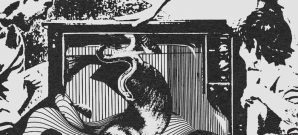 Bob Mould is one of the icons of alternative & punk, from being in one of the definitional bands of eighties punk, Hüsker Dü, to his nineties alt-rock breakthrough group Sugar and his lengthy solo work, going back four decades in total. For the twentieth anniversary of him going solo, Mould has put it all together the absolutely massive, 24-CD collection, Distortion 1989-2019, which contains all of his solo & Sugar studio albums, live records, and more.
Bob Mould is one of the icons of alternative & punk, from being in one of the definitional bands of eighties punk, Hüsker Dü, to his nineties alt-rock breakthrough group Sugar and his lengthy solo work, going back four decades in total. For the twentieth anniversary of him going solo, Mould has put it all together the absolutely massive, 24-CD collection, Distortion 1989-2019, which contains all of his solo & Sugar studio albums, live records, and more.
First things first, this is a giant box set that is for Bob Mould enthusiasts only. No one is going to get this who doesn’t already love Bob Mould, doesn’t already have most of the albums on it. Yes, the quality is finer, but it was already pretty fine, though maybe your old Sugar CDs have got some scratches on them or you uploaded them to your computer on a low bit-rate. Anyone reading this doesn’t need to be told much about his regular releases or how good they still are.
Second things second, this is ‘only’ his post-Hüsker work. Those eighties albums are still locked in whatever copyright issue hell SST Records holds its back catalog. And this is meant to be a collection of Bob Mould and Bob Mould alone, not that multiple songwriter band, with almost all of the near-three hundred tracks written solely by him.
First solo album Workbook (1989) remains as beautiful as you remember (QRO deluxe edition review), from the first harmonies of instrumental “Sunspots”. The all-acoustic album was a surprising departure from his loud, punk rock Hüsker Dü days, but that’s what it was meant to be, to show another side of Mould that has now become as developed. The following year’s Black Sheets of Rain returned to the electric, but retained the great intricacies – and the title track was pretty damn prescient (QRO interview with Bob Mould from on-fire West Coast).
For most of those who didn’t know Mould from Hüsker Dü, they met him in Sugar and their 1992 alternative rock hit Copper Blue, maybe the record with the most critical and commercial acclaim that Mould has ever done (QRO deluxe edition review), and of course it still holds up, from the hard rock “A Good Idea” to the heartbreaking “If I Can’t Change Your Mind” and more (the only problem is that there’s no forgotten gems, because every track has long been a standout). The following year’s mini-LP Beaster was a strange follow-up at the time, but fits more in context on Distortion. 1994’s File Under: Easy Listening is the catchy full-length follow-up you were looking for (not actual “easy listening,” but has great abbreviation of FU:EL), maybe Mould with his most pop sensibilities with songs like “Gee Angel”, but also the shoegaze “Gift” and yet more break-up “Explode and Make Up”. Also included is Sugar’s great b-sides collection (with the great name) Besides, which includes some alternate mixes, live versions, and original pieces such as killer opener “Needle Hits E” – even some written & sung by Sugar bassist David Barbe, rare tracks on Distortion not written by Mould (Barbe has gone on to do everything from produce Drive-By Truckers and run the music business program at University of Georgia).
Bob Mould’s immediate post-Sugar work around the turn of the millennium has long been seen as a relative nadir in his career, but a lot of that comes from not being the catchier Sugar or his impressive solo debut. But there are some definite overlooked gems on 1996’s moody Bob Mould, like single “Egøverride” and the fascinating “Fort Knox, King Solomon” (which brings to mind an even trippier Workbook’s “Brasilia Crossed With Trenton”). 1998’s The Last Dog and Pony Show got a bad rap just for possibly/supposedly being Mould’s ‘last rock album,’ giving the impression that he didn’t even like, as well as being another moody release, but it has some great more active songs such as “Moving Trucks” and “Classifieds”.
Then comes Mould’s electronic phase, much derided at the time. 2002’s Modulate was very much not-what-fans-were-looking-for, and what they feared after Pony’s electronic outlier “Megamanic”. But electronica is so big now that it’s abbreviated EDM, so you can say that Mould was ahead of the curve. Yet also, longtime Mould fans probably don’t like that synthesizers are so big that no plays guitars anymore. Maybe the likes of “Sunset Safety Glasses” would kill for the kids in the club, but the old fogies who’d buy Distortion will likely skip over all the effects they didn’t like the first around on Modulate, an album that does sound better today, but still isn’t the Mould you’re looking for, even with more electronic rock pieces such as “Soundonsound” and “Comeonstrong”.
Even before the poor reception that Modulate received, Mould had been moving his electronica work to new names. There was LoudBomb (an anagram of “Bob Mould”), whose Long Playing Grooves also came out in 2002, and four year later his team-up with keyboardist Richard Morel, Blowoff’s self-titled record. For many Mould fans, even those that’d purchase a mammoth discography like Distortion, these records “flew under the radar” (QRO interview with Mould), as after Modulate, few Mould fans were looking for an even more electronic Mould. But like with Modulate, this kind of material is a lot more familiar these days (as Mould noted in his 2011 autobiography, See a Little Light – QRO review) – and Mould fans probably aren’t happy about it (cue, “Rock is dead!”).
LoudBomb is ‘easy listening’ like much electronica, no harsh techno-industrial sounds, but also aren’t the club-thumpers that the kids are so into. Indeed, while Mould may have been ahead of his time in going electronic, his actual electronic sounds hew to the less impressive nineties electronica that didn’t launch in America and was already kind of as old hat as cyberpunk. It feels a little too enamored in being electronic, in using electronic instruments (probably as it’s coming from a guitarist), than just taking that as a given and building from there, which is what has launched EDM in the twenty-first century. Interestingly, it is his team-up with a keyboardist that is less electronic, Blowoff hewing more towards the electronic rock (despite being, with the few Barbe Sugar era songs & some covers, the only material throughout Distortion not written exclusively by Mould). While not without relative standouts such as each record’s openers, Long Playing’s “Theme (It’s a Perfect Day)” and Blowoff’s “Hormone Love”, likely most people who buy Distortion will listen to them once, maybe twice, and then forget, certainly leave off playlists or record players.
But those were just detours, as Mould returned to his rocking ways in the twenty-first century. 2005’s Body of Song actually came between LoudBomb & Blowoff, and does have more electronically influenced pieces such as “(Shine Your) Love Light Hope” and “I Am Vision I Am Sound”. Notably, the incorporation of the electronic into the indie-rock works better with songs like “Circles” and “Paralyzed”, though other tracks like “Vision” still suffer. That improving trajectory continues with 2008’s District Line (QRO review). There is the strong electronic rock in opener “Stupid Now”, but also the heartbreak of his nineties heyday in “Again and Again”, though not all of the songs are as memorable. The struggle between Mould’s original rock sensibilities and more recent electronic ideas continues with 2009’s Life and Times (QRO review), which does dip a bit here – aside from another heartbreak standout, “I’m Sorry, Baby, But You Can’t Stand In My Light Any More”, that, like “Again”, feels as if it’s from another record – but the album also deserves another play, as it might have been a bit overlooked at the time, coming so soon after District.
Bob Mould’s real step into his current great age comes with 2012’s Silver Age (QRO review), an indie-punk revival that he so knows how to kick. This was around when he started performing in a trio again, with bassist Jason Narducy (QRO interview) and drummer Jon Wurster, and releasing on great indie imprint Merge Records (Narducy & Wurster also play in the band that founded Merge, Superchunk). Mould is just more comfortable in his skin on Silver, accepting his age and ‘rock veteran’ status – just look at the album’s opening one-two “Star Machine” and the title track. Longtime fans who’ve purchased Distortion likely already loved Silver Age, but it’s still a great excuse to revisit a great album.
The success of Silver Age continues with Mould’s most recent records, as he embraced all of his past sides. 2014’s Beauty & Ruin (QRO review) has everything from the hard-hitting Hüsker-esque “Little Glass Pill” to the catchy “I Don’t Know You Anymore”. 2016’s Patch the Sky (QRO review) was meant to sort of be the third of a trilogy with Silver and Ruin, and does feel that way, a similar summing up of Mould like the pressing alt-rock “The End of Things” or the soul-bearing opener “Voices In My Head”. And the collection of studio albums ends with last year’s Sunshine Rock (QRO review) a new age of Mould dawning from the titular opener to “Western Sunset” closer.
Unfortunately, Distortion does not include Mould’s most recent record, this year’s Blue Hearts (QRO review), because he’s not slowing down to look back.
But there is much more to the massive collection than ‘just’ the studio albums. There are four-count-‘em-four live records (albeit all previously released). Live At ATP 2008 sees the Bob Mould Band’s twenty-first century rise in full fury (QRO live review in 2008), remarkably with a set broken about evenly between his solo material, Sugar, and Hüsker Dü (you knew some Hüsker was going to get into Distortion), as Mould was becoming more comfortable with his past & playing it live, from Sugar’s “The Act We Act” opener to the Hüsker “New Day Rising” closer (but also has his own “I Hate Alternative Rock”). Live at Cabaret Metro 1989 had been the bonus disc for the Workbook deluxe edition (QRO review), showcasing Mould at the start of his solo career, playing the acoustic Workbook songs electric (along with a few Hüsker tracks at the end), which lets the longtime fan hear those songs in a different light (and even includes one song “Not on the album, I hope you like it,” “If You’re True”, plus a cover of Richard Thompson’s “Shoot Out the Lights”, neither included anywhere else on the 24 discs). Sugar’s The Joke Is Always On Us, Sometimes live record had been part of the initial Besides release, letting that group’s nineties power shine, including some live b-sides like “Clownmaster” & “Running Out of Time” and Barbe non-record songs like “Where Diamonds Are Halos” & “In the Eyes of My Friends”. Bob Mould Band’s LiveDog98 is the live album collection listeners are least likely to have already, taking place in a less popular phase of his career, so one gets to hear those moody, perhaps overlooked post-Sugar solo songs (but still before his true electronic phase) such as “Art Crisis” & “Roll Over and Die” in live Mould power.
And finally, there are the bonus tracks, the real reason a fan gets a collection of records he or she already has. And Distortion has it, twenty-six tracks over two albums of Distortion Plus: 1989-2019. Admittedly, some of the songs have already been released, like on 1994’s Poison Years (a collection that Mould himself said was inessential, indeed was just Virgin Records trying to make more money). But it’s always great to hear “All Those People Know” again to start the bonus, and from there on it is mostly songs you hadn’t heard. Of course, there are those pieces that earned their slot on the cutting room floor (hard guitar instrumental “No Water In Hell”, electronica era “Love Escalator”), but then there are wonderful numbers such as “Know” and “Can’t Fight It” (Mould’s contribution to the seminal 1993 height-of-alternative-music benefit compilation, No Alternative). Perhaps most significantly, there is the demo for “Dog On Fire”, a.k.a. what became The Daily Show theme song, which Mould said in his autobiography See a Little Light (QRO review) was probably his most-heard song ever, and ‘got him a house.’ There are also some more live recordings, like Mould not only playing “I Hate Alternative Rock” at Minneapolis’ First Avenue (the iconic venue where Hüsker Dü reigned) and ending it by literally just saying that he hates alternative rock, and three Hüsker songs from the 2005 Circle of Friends DVD (QRO review) at Washington, D.C.’s 9:30 Club in 2005. And it ends with maybe the best surprise on Plus, the catchy “I Don’t Mind”.
At two hundred-and-ninety-six tracks, just under twenty hours of music, Distortion: 1989-2019 is a beast of a collection, and daunting even for the hardest core of Bob Mould fans. But it is great to relive twenty years of greatness (and a pandemic lockdown means you’ve got the time…), from the most popular & beloved to the most obscure & misunderstood. And here’s to twenty more years.


















